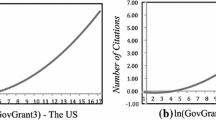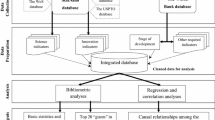Abstract
Nanotechnology is a promising research domain with potential and enormous economic value. It is widely acknowledged that nanotechnology, as an emerging and rapidly evolving field with the multidisciplinary nature, is perceived as proximate fields of science and technology. This study provides a further description of the relationship between science and technology at macro-level. The core objective in this paper is to qualify and assess the dynamic associations between scientific activity and technological output. We attempt to illustrate how science and technology relate one another in the case of innovation system. In this paper, we take advantage of the simultaneous equations model to analyze the reciprocal dependence between science and technology. Previous studies about the relationship between science and technology infrequently adopt this model. Our result shows that there is no significant connection between R&D expenditures and actual practices of research in terms of publications and patents for the universities in zone 1 and 2. Our results provoke questions about whether policy-makers should appropriately reallocate scientific and technological resources and other R&D expenditures so as to obtain optimal allocation for resource and achieve maximum results with little effort for scientific research and innovation performance.



Similar content being viewed by others
References
Albert, M. (2003). Universities and the market economy: The differential impact on knowledge production in sociology and economics. Higher Education, 45(2), 147–182.
Auranen, O., & Nieminen, M. (2010). University research funding and publication performance—an international comparison. Research Policy, 39, 822–834.
Bai, C. L. (2005). Ascent of nanoscience in China. Science, 309(5731), 61–63.
Becker, B., & Pain, N. (2003). What Determines Industrial R&D Expenditure in the UK? National Institute of Economic and Social Research (NIESR) discussion paper 211.
Bernardes, A., & Albuquerque, E. (2003). Cross-over, thresholds and interaction between science and technology: Lessons for less-developed countries. Research Policy, 32(5), 865–885.
Bradford, S. C. (1934). Sources of information on specific subjects. Engineering, 137, 85–86.
Braun, T., Schubert, A., & Zsindely, S. (1997). Nanoscience and nanotechnology on the balance. Scientometrics, 38(2), 321–325.
Brusoni, S., Prencipe, A., & Pavitt, K. (2001). Knowledge specialization, organizational coupling, and the boundaries of the firm: Why do firms know more than they make? Administrative Science Quarterly, 46(4), 597–621.
Butler, L. (2003). Explaining Australia’s increased share of ISI publications—the effects of a funding formula based on publication counts. Research Policy, 32(1), 143–155.
Carpenter, M. P., Cooper, M., & Narin, F. (1980). Linkage between basic research and patents. Research Management, 23, 30–35.
Chaves, C. V., & Moro, S. (2007). Investigating the interaction and mutual dependence between science and technology. Research Policy, 36, 1204–1220.
Cohen, W. M., & Levinthal, D. A. (1990). Absorptive capacity: A new perspective on learning and innovation. Administrative Science Quarterly, 35, 128–152.
Da Luz, M. P., Marques-Portella, C., Mendlowicz, M., Gleiser, S., Coutinho, E. S., & Figueira, I. (2008). Institutional h-index: The performance of a new metric in the evaluation of Brazilian psychiatric post-graduation programs. Scientometrics, 77(2), 361–368. doi:10.1007/s11192-007-1964-9.
Debackere, K., & Veugelers, R. (2005). The role of academic technology transfer organizations in improving industry science link. Research Policy, 34, 321–342.
Dosi, G. (1988). Sources, procedures and microeconomic effects of innovation. Journal of Economic Literature, 27, 1126–1171.
Etzkowitz, H., & Leydesdorff, L. (1997). Universities and the global knowledge economy: A triple helix of university-industry-government relations. London: Cassell Academic.
Evenson, R., & Kislev, Y. (1975). Agricultural research and productivity. New Haven: Yale University Press.
Evenson, R., & Kislev, Y. (1976). A stochastic model of applied research. Journal of Political Economy, 84(2), 265–281.
Fleming, L., & Sorenson, O. (2004). Science as a map in technological search. Strategic Management Journal, 25(8–9), 909–928.
Geuna, A. (1999). The economics of knowledge production: Funding and the structure of university research. Cheltenham: Edward Elgar.
Geuna, A., & Nesta, L. J. J. (2006). University patenting and its effects on academic research: The emerging European evidence. Research Policy, 35(6), 790–807.
Griliches, Z. (1990). Patent statistics as economic indicators: A survey. Journal of Economic Literature, 28(4), 1661–1707.
Grossman, G., & Helpman, E. (1991). Quality ladders in the theory of growth. Review of Economic Studies, 58(1), 43–61.
Grupp, H. (1994). The dynamics of science-based innovation reconsidered: Cognitive models and statistical findings. In O. Granstrand (Ed.), Economics of technology (pp. 223–251). Amsterdam: Elsevier.
Grupp, H. (1996). Spillover effects and the science-based of innovations reconsidered: An empirical approach. Journal of Evolutionary Economics, 6, 175–197.
Grupp, H., & Schmoch, U. (1992). Perception of scientification of innovation as measured by referencing between patents and paper-dynamics in science-based fields of technology. In H. Grupp (Ed.), Dynamics in science-based innovation (pp. 73–128). Berlin: Springer.
Guan, J. C., & Ma, N. (2007). China’s emerging presence in nanoscience and nanotechnology: A comparative bibliometric study of several nanoscience ‘giants’. Research Policy, 36(6), 880–886.
Guan, J. C., & Wang, G. B. (2010). A comparative study of research performance in nanotechnology for China’s inventor–authors and their non-inventing peers. Scientometrics, 84, 331–343.
Hassan, M. (2005). Small things and big changes in the developing world. Science, 309(5731), 65–66.
Hausman, J., Hall, B., & Griliches, Z. (1984). Econometric models for count data with an application to the patents-R&D relationship. Econometrica, 52, 909–938.
Hullmann, A., & Meyer, M. (2003). Publications and patents in nanotechnology: An overview of previous studies and the state of the art. Scientometrics, 58(3), 507–527.
Jin, B., Rousseau, R., & Sun, X. (2005). Key labs and open labs in the Chinese scientific research system: Qualitative and quantitative evaluation indicators. Research Evaluation, 14(2), 103–109.
Klevorick, A., Levin, R., Nelson, R., & Winter, S. (1995). On the sources and significance of inter-industry differences in technological opportunities. Research Policy, 24, 185–205.
Kline, S. J., & Rosenberg, N. (1986). An overview of innovation. In R. Laudan & N. Rosenberg (Eds.), The positive sum strategy, harnessing technology for economic growth (pp. 275–306). Washington: National Academy Press.
Kondo, M. (1990). Japanese R&D in robotics and genetic engineering. In J. Sigurdson (Ed.), Measuring the dynamics of technological change (pp. 130–145). London: Pinter.
Krahmer, M., & Schmoch, U. (1998). Science-based technologies: University-industry interactions in four fields. Research Policy, 27, 835–851.
Kumaresan, N., & Miyazaki, K. (1999). An integrated network approach to systems of innovation: The case of robotics in Japan. Research Policy, 28, 563–585.
Laudel, G. (2006). The art of getting funded: How scientists adapt to their funding conditions. Science and Public Policy, 33(7), 489–504.
Leydesdorff, L., & Meyer, M. (2003). The triple helix of university-industry-government relations. Scientometrics, 58(2), 191–203.
Leydesdorff, L., & Zhou, P. (2005). Are the contribution of China and Korea upsetting the world system of science? Scientometric, 63(3), 617–630.
Leydesdorff, L., & Zhou, P. (2007). Nanotechnology as a field of science: Its delineation in terms of journals and patents. Scientometrics, 70(3), 693–713.
Mcmillan, S., Narin, F., & Deeds, D. (2000). An analysis of the critical role of public science in innovation: The case of biotechnology. Research Policy, 29, 1–8.
Meyer, M. (2006). Are patenting scientists the better scholars? An exploratory comparison of inventor–authors with their non-inventing peers in nanoscience and technology. Research Policy, 35(10), 1646–1662.
Meyer, M., Debackere, K., & Glanzel, W. (2010). Can applied science be ‘good science’? Exploring the relationship between patent citations and citation impact in nanoscience. Scientometrics, 85(2), 527–539.
Ministry of Education. (1999). The regulation regarding the protection and management of intellectual properties in higher education institutions. Act 3, No. 8120.
Mogoutov, A., & Kahane, B. (2007). Data search strategy for science and technology emergence: A scalable and evolutionary query for nanotechnology tracking. Research Policy, 36(6), 893–903.
Mowery, D. C. (1983). Industrial research and firm size, survival, and growth in American manufacturing, 1921–1946: An assessment. Journal of Economic History, 43(4), 953–980.
Narin, F., & Breitzman, A. (1995). Inventive productivity. Research Policy, 24, 507–519.
Narin, F., & Noma, E. (1985). Is technology becoming science? Scientometrics, 7, 369–381.
Nelson, R. (1982). The role of knowledge in R&D efficiency. Quarterly Journal of Economics, 97, 453–470.
Nelson, R., & Rosenberg, N. (1993). Technical innovation and national systems. In R. Nelson (Ed.), National innovation systems: A comparative analysis (pp. 3–21). Oxford: Oxford University Press.
Nightingale, P. (1998). A cognitive model of innovation. Research Policy, 27, 689–702.
Palmberg, C., Dernis, H., & Miguet, C. 2009 Nanotechnology: An overview based on indicators and statistics [EB/OL]. OECD Science, Technology and Industry working papers, 2009/7. OECD Publishing. doi:10.1787/223147043844.
Porter, A. L., Youtie, J., Shapira, P., & Schoeneck, D. J. (2008). Refining search terms for nanotechnology. Journal of Nanoparticle Research, 10(5), 715–728.
Price, D. J. D. (1965). Is technology historically independent of science—a study in statistical historiography. Technology and Culture, 6(4), 553–568.
Rao, I. K. R., & Srivastava, D. (2010). Growth of journals, articles and authors in malaria research. Journal of Informetrics, 4(3), 249–256.
Rip, A. (1992). Science and technology as dancing partners. In P. Kroes & M. Bakker (Eds.), Technological development and science in the industrial age (pp. 231–270). Dordrecht: Kluwer.
Rosenberg, N. (1982). How exogenous is science? In N. Rosenberg (Ed.), Inside the black box: Technology and economics (pp. 141–159). Cambridge, MA: Cambridge University.
Sampson, R. (2004). The cost of misaligned governance in R&D alliances. Journal of Law, Economics, and Organization, 20, 484–526.
Schilling, M. A., & Phelps, C. C. (2007). Interfirm collaboration networks: The impact of large-scale network structure on firm innovation. Management Science, 53(7), 1113–1126.
Schmoch, U. (1997). Indicators and the relations between science and technology. Scientometrics, 38, 103–116.
Schummer, J. (2004). Multidisciplinarity, interdisciplinarity, and patterns of research collaboration in nanoscience and nanotechnology. Scientometrics, 59(3), 425–465.
Stankiewics, R. (1992). Technology as an autonomous, socio-cognitive system. In H. Grupp (Ed.), Dynamics of science based innovation (pp. 19–44). Berlin: Springer.
Stefano, B., & Christian, C. (2010). Tracing the links between science and technology: An exploratory analysis of scientists’ and inventors’ networks. Research Policy, 39, 14–26.
Stuart, T. E. (2000). Interorganizational alliances and the performance of firms: A study of growth and innovation rates in a high technology industry. Strategic Management Journal, 21, 791–812.
Tseng, F. M., Hsieh, C. H., Peng, Y. N., & Yi-Wei Chua, Y. W. (2011). Using patent data to analyze trends and the technological strategies of the amorphous silicon thin-film solar cell industry. Technological Forecasting and Social Change, 78(2), 332–345.
Vanlooy, B., et al. (2003). Do science–technology interactions pay off when developing technology? An exploratory investigation of 10 science-intensive technology domains. Scientometrics, 57(3), 355–367.
Vanlooy, B., et al. (2006). Scientific capabilities and technological performance of national innovation systems: An exploration of emerging industrial relevant. Scientometrics, 66(2), 295–310.
Wang, G. B., & Guan, J. C. (2010). The role of patenting activity for scientific research: A study of academic inventors from China’s nanotechnology. Journal of Informetrics, 4, 338–350.
Wong, C. Y., & Goh, K. L. (2009). Modeling the dynamics of science and technology diffusion of selected Asian countries using a logistic growth function. Asian Journal of Technology Innovation, 17(1), 75–100.
Wong, C. Y., & Goh, K. L. (2010). Modeling the behaviour of science and technology: Self-propagating growth in the diffusion process. Scientometrics, 84, 669–686.
Zhao, W., & Watanabe, C. (2008). A comparison of institutional systems affecting software advancement in China and India: The role of outsourcing from Japan and the US. Technology in Society, 30, 429–436.
Ziman, J. (1996). “Post-academic science”: Constructing knowledge with networks and norms. Science Studies, 9(1), 67–80.
Zitt, M., & Bassecoulard, E. (2006). Delineating complex scientific fields by an hybrid lexical-citation method: An application to nanosciences. Information Processing & Management, 42(6), 1513–1531.
Acknowledgments
This research is funded by the National Natural Science Foundation of China (Project no. 70773006), the National Social Science Foundation of China (Project no. 10zd&014), key discipline excellent doctoral research funded projects in Fudan University and Introduce talents project in Chongqing University of Arts and Sciences.
Author information
Authors and Affiliations
Corresponding author
Additional information
The authors have contributed equally to this work.
Rights and permissions
About this article
Cite this article
Zhao, Q., Guan, J. Modeling the dynamic relation between science and technology in nanotechnology. Scientometrics 90, 561–579 (2012). https://doi.org/10.1007/s11192-011-0520-9
Received:
Published:
Issue Date:
DOI: https://doi.org/10.1007/s11192-011-0520-9




